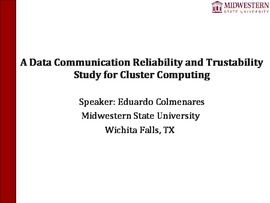| dc.contributor.author | Colmenares, Eduardo | |
| dc.date.accessioned | 2015-11-02T23:30:51Z | |
| dc.date.available | 2015-11-02T23:30:51Z | |
| dc.date.issued | 2015-09-23 | |
| dc.identifier.uri | https://hdl.handle.net/11244/20913 | |
| dc.description | Biography
Dr. Eduardo Colmenares is an Assistant Professor of Computer Science at Midwestern State University. He received his BS in Electronics Engineering from the Industrial University of Santander, Colombia, his Master of Science and PhD in Computer Science from Texas Tech University, both with Focus in High Performance Computing and Scientific Computing. For his doctoral work at Texas Tech University, Dr. Colmenares studied a kernel of scientific relevance in multiple fields of science, the All-Pairs Shortest Path (APSP) problem. He developed an algorithmically restructured solution for the APSP that makes use of non-blocking features supported by a heterogeneous multi-core architecture, in order to minimize the effects of the intense data sharing among processors and to target better performance than the traditional and pipelined approaches. | en_US |
| dc.description.abstract | Abstract
In High Performance Computing (HPC), most of the problems under study will be either embarrassingly parallel or data dependent. Beyond the nature of the problem, scientists will be interested in either one or two additional characteristics. The first, performance, focuses in achieving an accurate solution in a fraction of the time of a sequential approach. The second is consecutive, accurate and steady time readings. In their quest for performance, some scientists forget not only that the chosen tool, in many cases a distributed-memory system, is a multi-user system, but also that its components are interconnected through a high-speed communications network to facilitate the interaction among processors. In this talk, we show why a cluster characterization is relevant, particularly for scientific kernels where multiple accurate and consecutive time readings are necessary to statistically validate a behavior. We present the characterization of two clusters by using two variants of the ping pong test. One of the clusters is a multi-user research oriented cluster, while the second is a one-user cluster with older technology. | en_US |
| dc.description.sponsorship | The University of Oklahoma; The University of Oklahoma Supercomputing Center for Education & Research (OSCER); The University of Oklahoma Department of Information Technology; 2015 Oklahoma Supercomputing Symposium; Midwestern State University | en_US |
| dc.language | en_US | en_US |
| dc.relation.ispartofseries | 2015 Oklahoma Supercomputing Symposium; | |
| dc.subject | Computer Science | en_US |
| dc.title | A Data Communication Reliability and Trustability Study for Cluster Computing | en_US |
| dc.type | Presentation | en_US |
| dc.description.peerreview | No | en_US |
| ou.group | Oklahoma Supercomputing::Oklahoma Supercomputing Symposium::2015 | en_US |
